HOW TO GET STARTED?
10 questions and 10 answers for the novice motorist
Decide what you want to do. Next, check out the regulations and technical conditions of the respective area on autosport.ee. If anything is unclear, contact the subcommittee responsible for the area. You can find contacts on autosport.ee.
Options depending on age. The youngest participant can be six years old in the Cadet sword class, with the number of opportunities increasing as the age increases. The Talents on Track and Young at the Wheel competitions are a great way to get started in motorsport.
Saab. The easiest way to try is to organise a hobby card competition with friends. Children have the opportunity to participate in series that do not require equipment, such as the aforementioned Talents on Track and Youth at Wheel. Adults have the option of renting a car from a team. Subcommittees are best placed to help, as opportunities vary from area to area.
Competitor's licence. The conditions for applying for this vary somewhat from one area to another, but one thing is common - you need to know the rules of motorsport. Once these are clear, the licence can be purchased from autosport.ee.
For children and young people, the cheapest options are the Talent on Track and Youth at the Wheel series, which do not require racing equipment. If you take part with your own vehicle, you can take part in the popular street racing events, where you can take part in a street car or a slightly modified street car.
There are two ways to go: buy a ready-made racing car or build/build it from a street car. If you buy a new and ready-made competition car, everything is simple; if you buy a used one, in addition to the resources you have left over, you have to check whether the car meets the current requirements of the sport you are competing in. When building a car, the technical conditions of the area must be strictly observed, as subsequent modifications can be very expensive. The subcommittees and the technical committee can advise.
If you don't have any experience, it's worth checking with the subcommittees for contacts with clubs and car builders. There is no single "information line", as the requirements and construction principles are very different in different areas, so, metaphorically speaking, what is good for a dragster may not be good for a truck. It pays to ask more rather than less, as correcting mistakes on matters of principle can be very costly.
Equipment requirements vary from one area to another and are described in the documents for each area. Estonian equipment dealers are helpful and knowledgeable about motorsport, so it's definitely worth consulting them. Of course, the price of the same item may vary from shop to shop and you may well end up buying a set from several different places.
Costs vary widely from one sector to another, very much depending on how much work has to be contracted out in building, maintaining and repairing the car and how much the racer can do himself. It's one thing to equip your everyday car with a northern fender and take it to rallies, it's another to drive a top rally car in the Estonian championship. There is no better way to answer this question than to try to estimate your costs for car sports and compare them with your income. And take into account that the actual costs will be higher than forecast anyway.
There really is a difference between road racing and sports driving. First you need to familiarise yourself with the basics of car dynamics, then the ABCs of sport driving and the specifics of your chosen field. The internet offers many opportunities, but again it is worth checking with the subcommittees to see if and who offers training. Obviously, rally training is different from drift training, and both of these are different from acceleration training. Skills are acquired and consolidated through practice on closed tracks - there's no point in saving on training kilometres.
